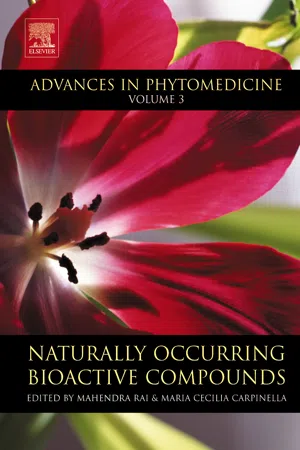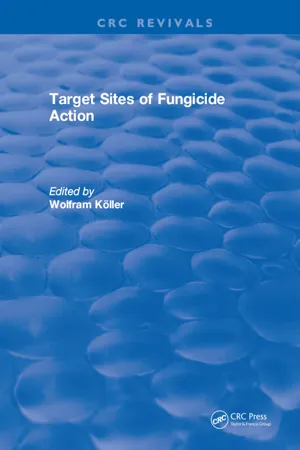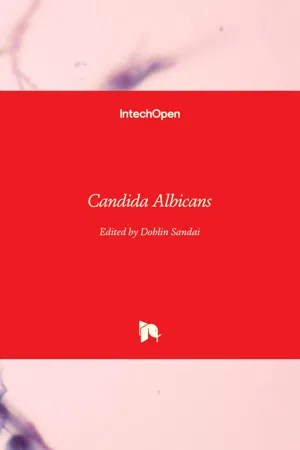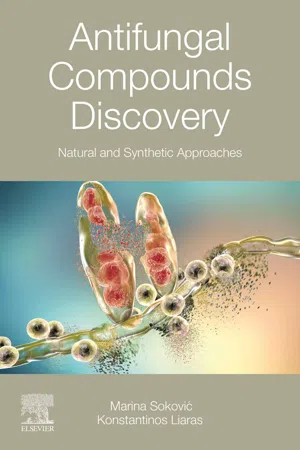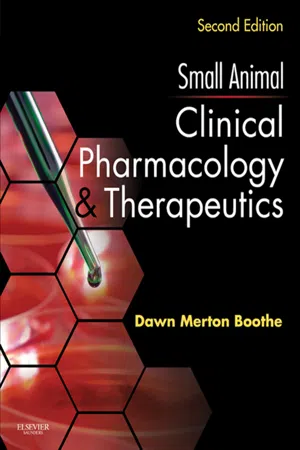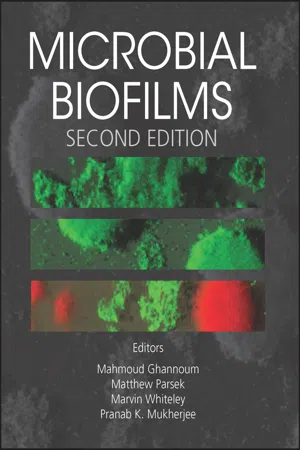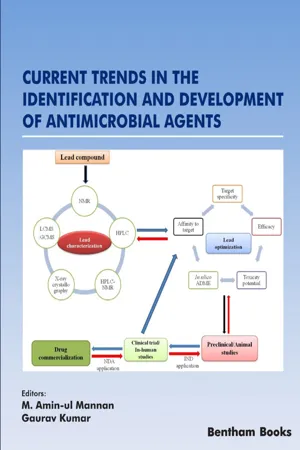Biological Sciences
Antifungal
Antifungal refers to substances or medications that are used to treat or prevent fungal infections. These can include topical creams, oral medications, or intravenous treatments. Antifungals work by targeting the fungal cells and inhibiting their growth or killing them, helping to alleviate symptoms and eradicate the infection.
Written by Perlego with AI-assistance
Related key terms
1 of 5
7 Key excerpts on "Antifungal"
- eBook - ePub
- (Author)
- 2006(Publication Date)
- Elsevier Science(Publisher)
Yang and del Rio, 2002 ). This approach generally favors fungicides that affect non-target mechanisms less than their synthetic analogues, and here natural products certainly constitute potential candidates. Consequently, there still exists interest in screening low-molecular-weight compounds for Antifungal activities within various research approaches that reflect themselves in the choice of assays. So far, key areas for the application of Antifungal bioassays include control of crop pathogens in phytopathology and human pathogenic fungi in antimycotic chemotherapy. Further, the authors opine that resource utilization and susceptibility to secondary metabolites will attract more attention in future to address basic ecological questions, such as the functioning and structuring of plant communities. In this context, the impact of microbial symbionts and pathogens will attract more attention as was hitherto been paid to.Antifungal modes of actions have been primarily elucidated for antimycotic drugs. The available antimycotic drugs show various modes of actions and, as a result of the dire consequences, resistance phenomena are much more attended to than in previous times, for a review see Baddly and Moser (2004) .Polyenes, such as amphotericin B (1 in Figure 1 ), are in use since the 1950s and bind to ergosterol units of the fungal cell membrane (Figure 1 ). Changes in the sterol content decrease binding of the drug and contribute to resistance. Further, an alteration in cell wall 1,3-β-D -glucan restricts the ability of this drug to reach its target site.Fig. 1 Antimycotics active at the cytoplasmic membrane. 1 , amphotericin B; 2 , the azole ketoconazole; 3 , the triazole fluconazole.Azoles constitute less toxic and effective alternatives to the former antimycotic. These compounds do not react with but inhibit the biosynthesis of ergosterol. Ketoconazole (2 in Figure 1 ) contains two nitrogen atoms in the five-membered azole ring whereas fluconazole (3 in Figure 1 ) contains three. Resistance to the azoles may be caused by several mechanisms: (1) enhanced efflux by up-regulation of multidrug efflux reporter genes (ABC transporter genes); (2) amino acid substitutions in the 14-α-demethylase (catalyzing the demethylation of 24-methylendihydrolanosterin); (3) up-regulation of the 14-α-demethylase gene ERG11; or (4) alterations in the ergosterol biosynthetic pathway (Figure 2 - eBook - ePub
- Wolfram Koeller(Author)
- 2018(Publication Date)
- CRC Press(Publisher)
12 Future antimycotic drugs must be fungal specific to warrant a long-term treatment of internal mycoses without side effects on the patient. Scientists engaged in the discovery of new Antifungal agents might be advised to cross disciplines more frequently in the future.Most of our modern fungicides and Antifungal drugs have been found via random synthesis, biological screening, and empirical optimization of lead structures. Some have been derived from natural product screening, an approach not fundamentally different from random synthesis. The modes of action of particular Antifungal groups were only identified in the late stages of development. Most often, this initial biochemical work was done by scientists at academic institutions and, thus, outside corporate research. Undoubtedly, the “screening approach” has been remarkably successful in the past, and the role and importance of molecular tools in the discovery of new Antifungal inhibitors is not immediately apparent. It is certainly justified that the “traditional” way of fungicide discovery and the eminent importance of appropriate and reliable screening systems and methods have been emphasized in recent reviews.13 , 14 Regardless of the undisputed merits of random synthesis and screening, however, continuous biochemical studies have yielded valuable contributions to fungicide discovery programs, in particular in the group of sterol demethylation inhibitors (Chapter 7 ) with a mode of action identified in 1974 and under continuous development for more than two decades.15 , 16 , 17 , 18 - eBook - PDF
- Doblin Sandai(Author)
- 2019(Publication Date)
- IntechOpen(Publisher)
Depending on the mode of action of the Antifungal compounds, the mechanism of resistance will be different [ 14]. The search for new Antifungal agents and the characterization of new targets that are more appropriate and efficient have been proposed [ 4 ]. Potential alternative therapies include the use of new active principles obtained from different general sources, such as natural prod -ucts, in particular, the plants that contain several components that are important sources of biologically active molecules [14]. 2. Brazilian medicinal plants tested against Candida spp.—by Vagner Rodrigues Santos 2.1. Introduction The search for therapeutic applications of medicinal plants and their derivatives has grown in the past years throughout the world. Several studies have been carried out in order to evaluate new biological properties from the biodiversity. The discovery of new antimicrobial components is of great relevance, particularly for dentistry, since bacterial and fungal infec-tions of the oral cavity are a relatively common problem: Candida albicans is an opportunistic yeast commonly identified in denture stomatitis and other oral candidosis clinical forms [ 12]. These are examples of infectious conditions of the mouth, and the resistance to antimicrobials in clinical cases has stimulated the search for natural agents as alternative treatments for the mouth infectious conditions. In Brazil, local communities use plants and their extracts for different medicinal purposes and take advantage of the availability of these plants and the low cost for product preparation. Plants have been used as antimicrobial, anti-inflammatory, wounds scarring, and antihemorrhagic agents, just to mention a few [16]. Medicinal plants continue to be widely used in rural and urban areas of Brazil. However, the intense miscegenation of crops over the last few centuries has more popularized the use of Candida Albicans 22 Candida Albicans - eBook - ePub
Antifungal Compounds Discovery
Natural and Synthetic Approaches
- Marina Sokovic, Konstantinos Liaras(Authors)
- 2020(Publication Date)
- Elsevier(Publisher)
AMR occurs as a natural process, where microorganisms could evolve and become more resistant. This process could be just slowed down by humans, but cannot be stopped completely. Through this process, bacteria and fungi will inevitably develop new ways for obtaining resistance to existing drugs. In order to stop emerging resistance, an aggressive strategy is needed, combining development of new drugs, introduction of modern diagnostic tests, and discovery of new sources, approaches, and methodologies to track and fight evolved strains.Discovery of new Antifungal drugs with desired properties, either from natural or semisynthetic or synthetic products, is a great challenge. For that purpose, combined efforts of scientists are taking place, from basic research on the field of fungi and employment of new sources, to innovative molecular approaches, known as combinatorial biosynthesis.In this book we are going to review existing Antifungal therapies and compounds, the past and current efforts of researchers and their achievements in discovering novel Antifungal drugs using combinatorial biosynthesis, but also to highlight new approaches and challenges, novel trends and possibilities.In particular, extensive data regarding natural and synthetic Antifungal agents will be presented in a way to help the reader understand the chemical components or moieties that are responsible for the activity observed. In that way, researchers will have the opportunity to focus on certain directions in their efforts to discover and/or synthesize, in general, compounds that will have higher chances to be effective Antifungals. Furthermore, through the discussion, SAR and comparisons that can be found in the chapters of this book, researchers will find useful information for discovering innovative molecules with potentially also unique or alternative modes of action to help overcome the emerging resistance to marketed drugs. - Dawn Merton Boothe(Author)
- 2011(Publication Date)
- Saunders(Publisher)
12 The advent of newer Antifungal agents and resistance among fungal organisms is, however, likely to cause in vitro testing of Antifungals to become more important to therapeutic success.KEY POINT 9-2 Resistance by fungal organisms is not as common as in bacterial organisms, but it is more likely in those that are rapidly growing.One author notes that never before have so many new Antifungals been under development, ranging from entirely new compounds with new targets to modifications of existing drugs (e.g., cyclodextrin–itraconazole and polyethylene glycol–amphotericin B).13 Newer concepts being explored include combinations of Antifungals with one another or with nonantibiotic compounds. Newer therapies may focus on immunomodulation14 with a balance between recruitment (cytokines, chemokines, lymphokines, and growth factors) and antiinflammatory effects. The need for new therapies is timely, as the epidemiologic behavior of fungal organisms, at least as they occur in human medicine, increasingly is shifting toward opportunistic organisms for which traditional Antifungals often are characterized by limited efficacy.7Antifungal Drugs
The primary agents used to treat fungal infections are the natural antibiotics; the polyene macrolides (amphotericin B as the prototype); the synthetic agents, including the azoles (ketoconazole as the prototype); and the newer allylamine Antifungals (Figure 9-2 ). Flucytosine has a less important role in the treatment of dimorphic fungal diseases, particularly in animals. The natural antibiotic griseofulvin belongs to no group but has an important place in the armamentarium against dermatophytosis. As recently as 1988, the treatment of systemic fungal infections in humans emphasized the use of amphotericin B, ketoconazole, and flucytosine. In the decade that followed, further development of the azole derivatives has led to a new age in the treatment of systemic fungal diseases. Currently, Antifungal therapy is most effective when based on an understanding of the therapeutic ratio of the drug in the infection being treated. For amphotericin B, this ratio tends to be small because of its toxicity. The newer azole derivatives have proved to provide much of the efficacy of amphotericin B without its toxicity. Doses for selected Antifungal drugs are found in Table 9-3- eBook - ePub
- Mahmoud Ghannoum, Matthew Parsek, Marvin Whiteley, Pranab K. Mukherjee, Mahmoud Ghannoum, Matthew Parsek, Marvin Whiteley, Pranab K. Mukherjee(Authors)
- 2015(Publication Date)
- ASM Press(Publisher)
19 From Biology to Drug Development: New Approaches to Combat the Threat of Fungal BiofilmsCHRISTOPHER G. PIERCE,1 , 3 ANAND SRINIVASAN,2 , 3 ANAND K. RAMASUBRAMANIAN,2 , 3 and JOSÉ L. LÓPEZ-RIBOT1 , 3INTRODUCTION
Advances in modern medicine are prolonging the lives of severely ill individuals; however, at the same time they are creating an expanding population of compromised patients at increased risk of suffering from invasive fungal infections (1 ). These include surgical, transplant, cancer, intensive care unit, and HIV-infected patients, as well as neonates. The use of broad-spectrum antibiotics, parenteral nutrition, medical implant devices, and immune suppression, as well as disruption of mucosal barriers due to surgery, chemotherapy, and radiotherapy represent the most important predisposing factors for these infections. Unfortunately, the mortality rates associated with these fungal infections remain unacceptably high, which clearly points to the many limitations of current Antifungal therapy, including the limited armamentarium of Antifungal agents, their inherent toxicity, and the emergence of resistance (2 –4 ). Fungi are eukaryotic organisms, and there is a paucity of selective targets which can be exploited for Antifungal drug development, while at the same time this is also the main reason for the elevated toxicity of some of the current agents (2 , 3 , 5 ). Only three classes of Antifungal agents—azoles, polyenes, and echinocandins—constitute the mainstay of Antifungal therapy for patients with life-threatening invasive fungal infections. Moreover, the Antifungal drug pipeline is mostly dry and, with the exception of isavuconazole, no new agents are expected to reach the market any time soon (2 ).The formation of biofilms by many pathogenic fungi further complicates treatment (4 ). Biofilms are attached and structured microbial communities surrounded by a protective exopolymeric matrix (6 –8 ). Once formed, these biofilms can initiate or prolong infections by providing a safe haven from which cells can invade local tissue, seed new infection sites, resist eradication efforts, and also lead to failure of implanted medical devices (9 , 10 ). For example, yeasts, and in particular Candida spp., are now the third most common microorganisms associated with catheter-related bloodstream infections (11 - M. Amin-ul Mannan, Gaurav Kumar, M. Amin-ul Mannan, Gaurav Kumar(Authors)
- 2008(Publication Date)
- Bentham Science Publishers(Publisher)
viz. polyenes, echinocandins, azoles, pyrimidine analogs, and allylamines. Moreover, a few synthetic molecules are also used as fungicidal agents. Despite the current Antifungal armamentarium, the burden of fungal infection is exacerbated by the emergence of drug resistance, host toxicity, and negative interactions with other drugs. The paucity of new Antifungal drugs has further complicated the treatment of fungal infections. These limitations provide a rationale for developing novel Antifungals preferably with new mechanisms and molecular targets. This chapter thus summarizes the currently used Antifungal drugs, their effective combinations, and the challenges inherent to the development of new Antifungal drugs. The chapter also addresses strategies to bolster the Antifungal pipeline involving emerging new targets for better management of fungal infections.Keywords: Antifungal agents, Antifungal drugs, Antifungal peptides, Azoles, Clinical trials, Echinocandins, Emerging targets, Ergosterol, Fungal diseases, Fungal infections, Fungal resistance, Mycosis, Multidrug resistance, Polyenes, Pyrimidine analogs.* Corresponding author Pooja Gulati: Department of Microbiology, Maharshi Dayanand University,Rohtak, Haryana, India; E-mail: [email protected]INTRODUCTION
Fungal diseases present a serious threat to human health, causing 1.5 million deaths annually [1 ]. The global burden caused by fungal diseases is underestimated due to the lack of diagnosis and public surveillance programs [2 ]. Even though fungi are ubiquitous in the environment and display an extensive diversity, only a few species are recognized as disease-causing pathogens in humans [3 ]. The majority of the fungal species are considered opportunistic pathogens, causing disease in immunosuppressed patients (like Candida and Aspergillus), while few can infect healthy humans (Histoplasma and Paracoccidioides). Lately, the clinical relevance of fungal diseases has substantially increased, owing to the rising population of immuno-compromised patients in large parts of the world. These high-risk individuals include those with multiple co-morbidities, HIV infection, organ transplantation, prolonged hospital stay, chemotherapy, and those treated with broad-spectrum antibiotics [4
Index pages curate the most relevant extracts from our library of academic textbooks. They’ve been created using an in-house natural language model (NLM), each adding context and meaning to key research topics.
